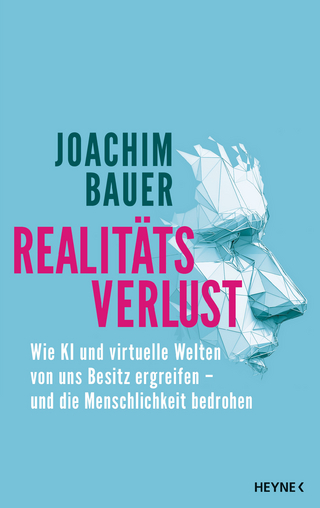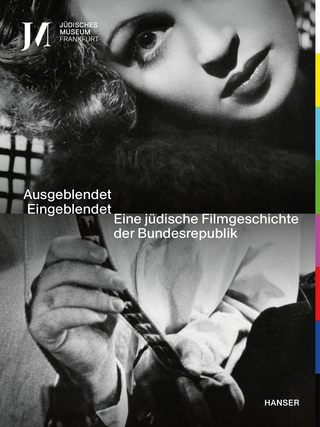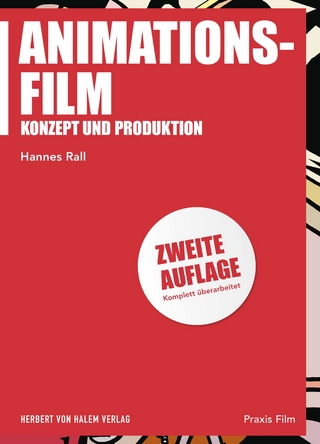
The Bloomsbury Handbook of Global Screenplay Theory
Bloomsbury Academic USA (Verlag)
978-1-5013-9406-5 (ISBN)
The sections are divided thematically, ranging from the screenplay as narrative form to sound and music in the screenplay. With both theorists and practitioners contributing to this volume, the focus is on the actual screenplay as opposed to analysis of the final film. Examining films like The Lion King and Slumdog Millionaire, the essays contribute to a new era in screenplay theory - providing valuable insights not only into the particular screenplays under analysis but also into the range of ways in which such analysis can be approached, representing a wide range of theoretical perspectives.
Andrew Gay is an Associate Professor of Digital Cinema at Southern Oregon University, USA. He has written pieces for the Journal of Screenwriting, Women Screenwriters: An International Guide, Toy Story: How Pixar Reinvented the Animated Feature, and in the forthcoming Handbook of Script Development, and the Open Educational Resource (OER) Screenplayology.com. Ann Igelstrom is an independent researcher based in Edinburgh, UK. She has written pieces for the Journal of Screenwriting and Screenwriters and Screenwriting: Putting Practice into Context. She serves as the Early Career Representative on the Screenwriting Research Network’s council and is in charge of the Network’s Facebook and Twitter accounts.
Introduction
Andrew Kenneth Gay, Southern Oregon University, US and Ann Igelstrom, Independent Researcher, UK
Part I: FADE IN: Theorizing Screenplay
Introduction
Andrew Kenneth Gay, Southern Oregon University, US and Ann Igelstrom, Independent Researcher, UK
Section I. I: The Screenplay as Object
1. An Ontology of the Screenplay as a Complex System
Paolo Russo, Oxford Brookes University, UK
2. Screenwriting in the Past Tense? Sergei Eisenstein's Theory of Literary Script, The General Line (1929), and the Use of Tenses in Screenplays
Alexandra Ksenofontova, Germany
3. Alan Sharp's Screenplay-Novel Hybrid Picture Yourself, and the Screenplay as Aesthetic Object
River Seager, University of Dundee, UK
4. Dance with Shadows: Screenwriting and the Diegetic Space in Brazilian Film History
Rafael Lea, Pontifical Catholic University, Brazil
Section I. II: The Screenplay as Process
5. Characterization, Dialogue, and Performance in Lawrence Kasdan's Screenplay for Raiders of the Lost Ark
Brett Davies, Meiji University, Japan
6. Everything I Don't Remember: Adapting Characters and Their Migratory Experiences
Joakim Hermansson, Dalarna University, Sweden
7. Maryam's Windows and Marziyeh's Screens: Layers of Processes, Poetics, and Authorship in 3 Faces, by Jafar Panahi
Márcio Andrade, Independent Scholar, Brazil
8. A Taxonomy for Writing Biopics based on Scant Evidence: The Return of Martin Guerre and Victoria & Abdul
Indranil Chakravarty, LV Prasad Academy of Film & TV, India
Section I. III: The Screenplay as Character and Meaning
9. "Such a foreign presence in Herfordshire": Screenwriting Black Female Nobility into British Heritage Cinema
Claudia Sternberg, University of Leeds, Uk
10. A Watchful Eye: the Dramatic Utility and Narrative Application of the Child's Gaze in En du elsker/Someone You Love (2014)
Cath Moore, University of Melbourne (Australia)
11. Exploring Characterization and Theme in the Screenwriting Process: The Case of Gladiator
Carmen Sofia Brenes, Universidad Gabriela Mistral, Chile and Universidad Internacional de la Rioja, Spain
12. Why Women Keep A Star (being) Born: How an 80 Year Franchise is Alive and Well Due to the Characterization and Dialogue of Female Screenwriters and the Performance of Female Superstars
Rosanne Welch, Stephens College, US
13. Moonlight and Mosquita y Mari: Centering the Black and Brown LGBTQ Coming of Age Narrative in Cinema
Elisha Miranda, San Jose State University, US and Desha Dauchan, University of California, Irvine, US
Part II: INT./EXT. The Screenplay as Narrative Text
Introduction
Andrew Kenneth Gay, Southern Oregon University, US and Ann Igelstrom, Independent Researcher, UK
Section II.I: Narrative Structure in the Screenplay
14. Imposing New Hollywood Structure on the Remake of 3:10 to Yuma
Mads Larsen, University of California, Los Angeles, US
15. Narrative Structure in Mari Okada's Maquia: When the Promised Flower Blooms, Japan (2018)
Max Gee, Bournemouth University, UK
16. Narrative Structure in the Screenplay of The Naked Island (1960)
Lauri Kitsnik, Hiroshima University, Japan
17. Narrative Structure in the Iranian Screenplay: Analysing Story Shape in Asghar Farhadi's The Salesman
Chris Neilan, Manchester Metropolitan University, UK
Section II.II: Narration and Focalization in the Screenplay
18. Writing Perspective and Perception into the Screenplay: The Case of I Lost My Body (2019)
Carina Böhm, Central Queensland University, Australia and Craig Batty, University of South Australia, Australia
19. "THE CAMERA IS JEAN-DOMINIQUE BAUBY": Focalizing Locked-In Syndrome in The Diving Bell and the Butterfly
Andrew Kenneth Gay, Southern Oregon University, US
20. The Hole at the Centre of the Donut: A Question of Character Perspective and Focalization in Knives Out
Ann Igelstrom, Independent Researcher, UK
21. Writing the Viewer: Narration and Perspective in a Cinematic Virtual Reality Screenplay
Kath Dooley, Curtin University, Australia
Section II.III: Narrative Time in the Screenplay
22. Time is Relative: a Modern and Postmodern Approach to Time in Kubrick's Shining
Kerstin Stutterheim, Academy of Media Arts Cologne, Germany
23. Playing with Time and Voice-Over in Eternal Sunshine of the Spotless Mind
Ann Igelstrom, Independent Researcher, UK
24. Time, Narrative and Boyhood
Carolina Amaral and Taiyo Omura, Independent Scholars, Brazil
25. The Strange Case of Angelica: Time and Rhythm in Manoel de Oliveira's Screenplay
Rita Benis, University of Lisbon, Portugal
Part III: CUT TO: The Screenplay as Cinematic Language
Introduction
Andrew Kenneth Gay, Southern Oregon University, US and Ann Igelstrom, Independent Researcher, UK
Section III.I: Mise-en Scene and Cinematic Space in the Screenplay
26. Visual Dramaturgy: From Miami Vice to Game of Thrones
Kerstin Stutterheim, Academy of Media Arts Cologne, Germany
27. The Dramatic Space in Beto Brant's Films: Confining and Expanding the Characters
Rubens Rewald, University of São Paulo, Brazil
28. Theme and the Humble Watermelon: The Battle for Identity in Sweet Country
Glenda Hambly, Monash University, Australia
Section III.II: Cinematography and Editing in the Screenplay
29. The Woman is Framed: Representing the Gaze in the Screenplay, One in a Million Girl
Louise Sawtell, University of South Australia, Australia
30. An Analysis of the Cinematographic and Editing Elements in the Screenplay for Federico Fellini's Le notti di Cabiria/Nights of Cabiria
Claudia Romanelli, University of Alabama, US
31. The Cut in Slumdog Millionaire
Greg Loftin, Ravensbourne University London, UK
32. Whatever Feels Right: Options for the Cut in Lynn Shelton's Your Sister's Sister Scriptment
Andrew Kenneth Gay, Southern Oregon University, US
Section III.III: Sound and Music in the Screenplay
33. Sound Design and Music Proposals in Lucrecia Martel's Swamp Screenplay
Iana Cossoy Paro, EICTV International Film School, Cuba
34. Screenwriting in Waltz Time: Role and Function of Music in the Walter Reisch's Screenplay for Two Hearts in Waltz Time (AT 1930)
Claus Tieber, University of Vienna, Austria
35. "What a Wonderful Phrase": Sequence, Selection and Scenography in the Animated Musical Screenplay, The Lion King (1994)
Paul Wells, Loughborough University, UK
Bibliography
Index
| Erscheint lt. Verlag | 13.6.2024 |
|---|---|
| Reihe/Serie | Bloomsbury Handbooks |
| Verlagsort | New York |
| Sprache | englisch |
| Maße | 178 x 254 mm |
| Themenwelt | Kunst / Musik / Theater ► Film / TV |
| Sozialwissenschaften ► Kommunikation / Medien ► Medienwissenschaft | |
| ISBN-10 | 1-5013-9406-1 / 1501394061 |
| ISBN-13 | 978-1-5013-9406-5 / 9781501394065 |
| Zustand | Neuware |
| Haben Sie eine Frage zum Produkt? |
aus dem Bereich


